Toyota Avalon
Key Fob Battery Replacement Guide
How to change the battery in the smart
key fob battery for a 4th generation 2013 to 2017 Toyota Avalon sedan.
By Paul B. Michaels Author & Photographer Auto Mechanic Since 1989 |
||
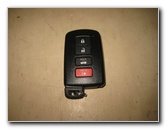 2016 Avalon Key Fob |
 Back Side of Smart Fob |
 Button - Side of Key Fob |
| This
automotive maintenance tutorial was specifically written to assist
owners of the fourth generation (2013, 2014, 2015, 2016, 2017 and
possibly also the revised 2018 model year) Toyota Avalon sedan in
changing a dead battery in the key fob remote control for the
keyless entry and push button start systems. Owners of other Toyota, Lexus and Scion vehicles such as the Yaris, Corolla, Matrix, Prius, Camry, RAV4, Sienna, Tacoma, Tundra, FJ Cruiser, Venza, Highlander, 4Runner, Sequoia, Land Cruiser, IS 250, IS 200t, IS 300, NX 200t, NX 300h, RX 350, RX 450h, LS 460, LS 600h, ES 350, ES 300h Hybrid, RC F, GS 350, CT 200h, LX 570, GX 460, tC, iA, iM, xB, xD, iQ and FR-S may also find these DIY instructions to be helpful. The compatible replacement coin cell (A.K.A. "button" or "watch") battery is part number CR2032 from various manufacturers such as Panasonic, Duracell, Energizer, Sony and Maxell. The only tool needed to access and replace the key fob battery is a small flathead screwdriver or a small plastic pry bar tool. |
||
|
|
||
 Press To Remove Key |
 Backup Metal Ignition Key |
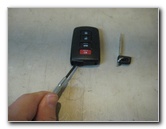 Insert Flathead Screwdriver |
| The first step is
to locate the backup metal ignition key release button on the side of the
fob. Press the button and slide out the metal ignition key. Set the key aside in a safe place. Then insert a small flathead screwdriver or a small plastic pry bar tool in to the notch on the bottom edge of the fob where the metal ignition key used to reside. Gently pry apart the two halves of the fob. |
||
 Pry Open Key Fob |
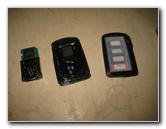 Remove Remote Control Unit |
 Gently Pry Out Battery |
| Lift the remote
control unit (green circuit board with buttons) out of the black plastic fob
case. Turn over the remote control unit to access the battery holder. Use your finger nail or the small flathead screwdriver to gently pry the old battery out of the socket. |
||
 Old Battery Removed |
 Panasonic CR 2032 3V |
 Empty Battery Socket |
| Try to avoid scratching the circuit board or bending the metal electrical contacts. | ||
|
|
||
 "+" Side Up, "-" Down |
 Install New Coin Battery |
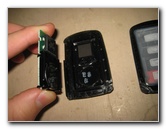 Lower In Remote Unit |
| Insert the new
CR2032 3 volt coin cell
battery in to the socket with the "+" positive side facing up towards you
and the "-" negative side facing down. Lower the remote control unit in the back cover of the fob with the battery facing down and the buttons facing up. |
||
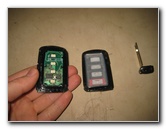 Circuit Board Installed |
 Line Up Two Halves |
 Snap Together Key Fob |
| Line up the rear of
the fob with the front half of the case and gently pop them back together. Make sure that the two halves of the fob are flush together at every edge. |
||
 Slide In Metal Ignition Key |
 Key Fob Re-Assembled |
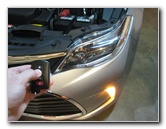 Test New Key Fob Battery |
| Push the backup /
emergency metal ignition key back in to the slot on the bottom of the fob
until it clicks securely in to place. To test the new battery, stand near your car and press the "Unlock" or "Lock" buttons. If the new battery is working properly, you should see the parking lights flash, hear the chirping noises and hear the door locks opening or closing. (If your smart key fob battery has been draining quickly and needs to be replaced every few months, try storing it away from other intelligent key fobs, charging cell phones, computers, TVs, RFID chip readers or similar electronics that may be keeping it "awake" and broadcasting a radio signal when it should be conserving power in "sleep" mode. If necessary, consider using a signal blocking "faraday cage" pouch or bag if you can't keep the fob battery from dying prematurely.) For more,
check out all of my
Toyota Avalon DIY Repair & Maintenance Guides. |
||
| If you found this guide to be helpful,
please consider making a small donation by clicking on the PayPal.com
"Donate" button located to the right of this paragraph. Thank you!
(Note: I am not a registered charity. Donations are not tax deductible.) |

